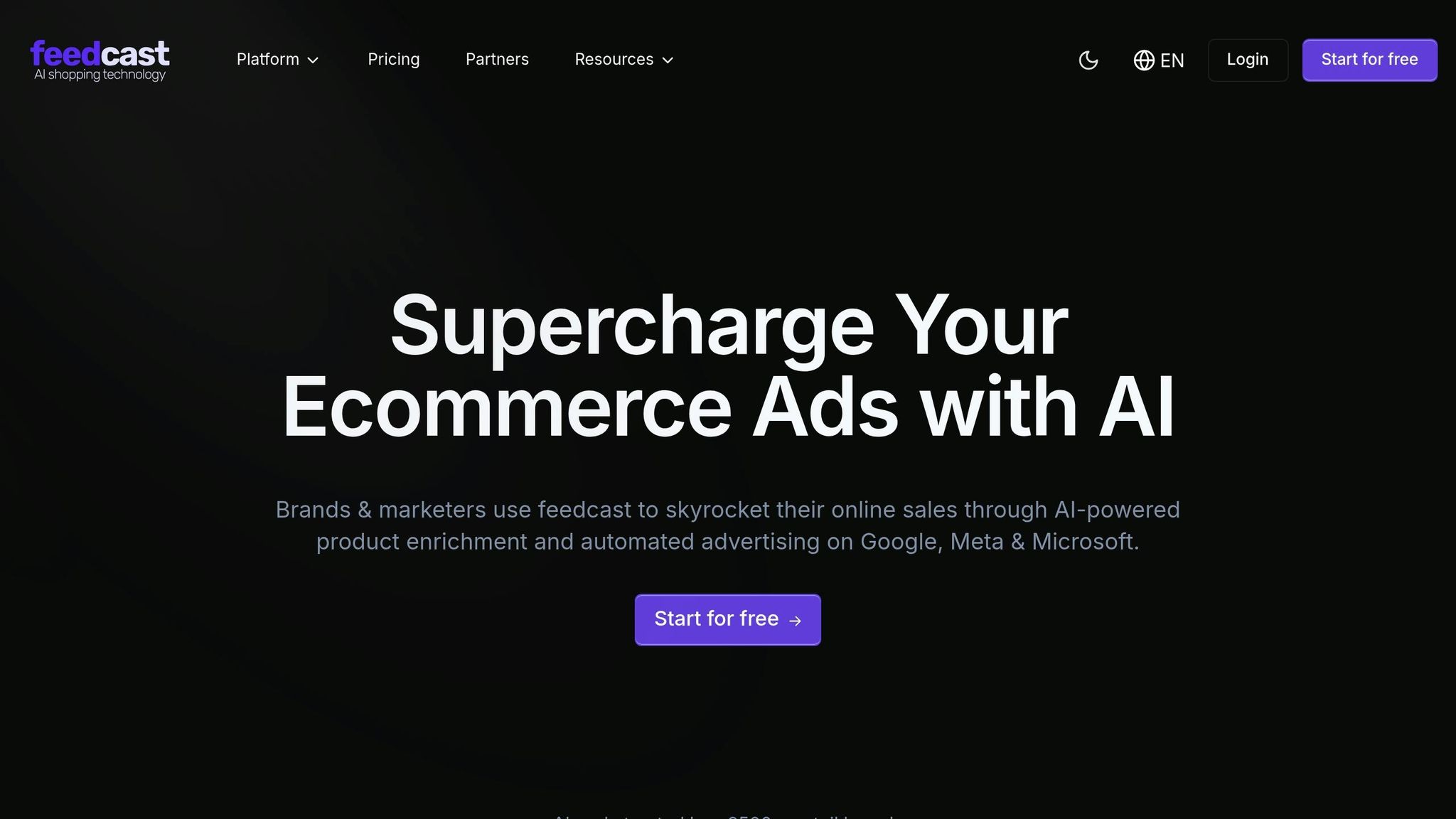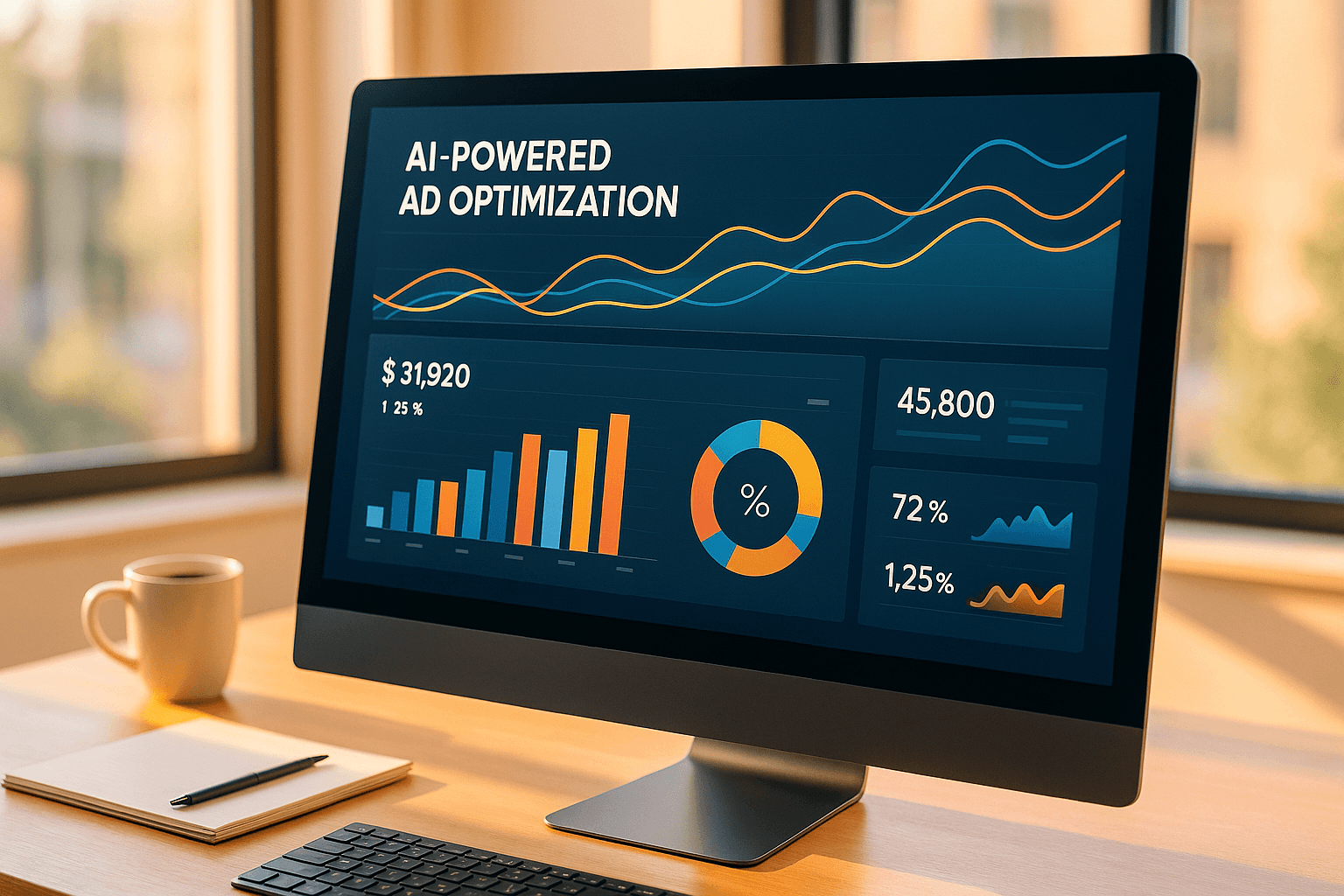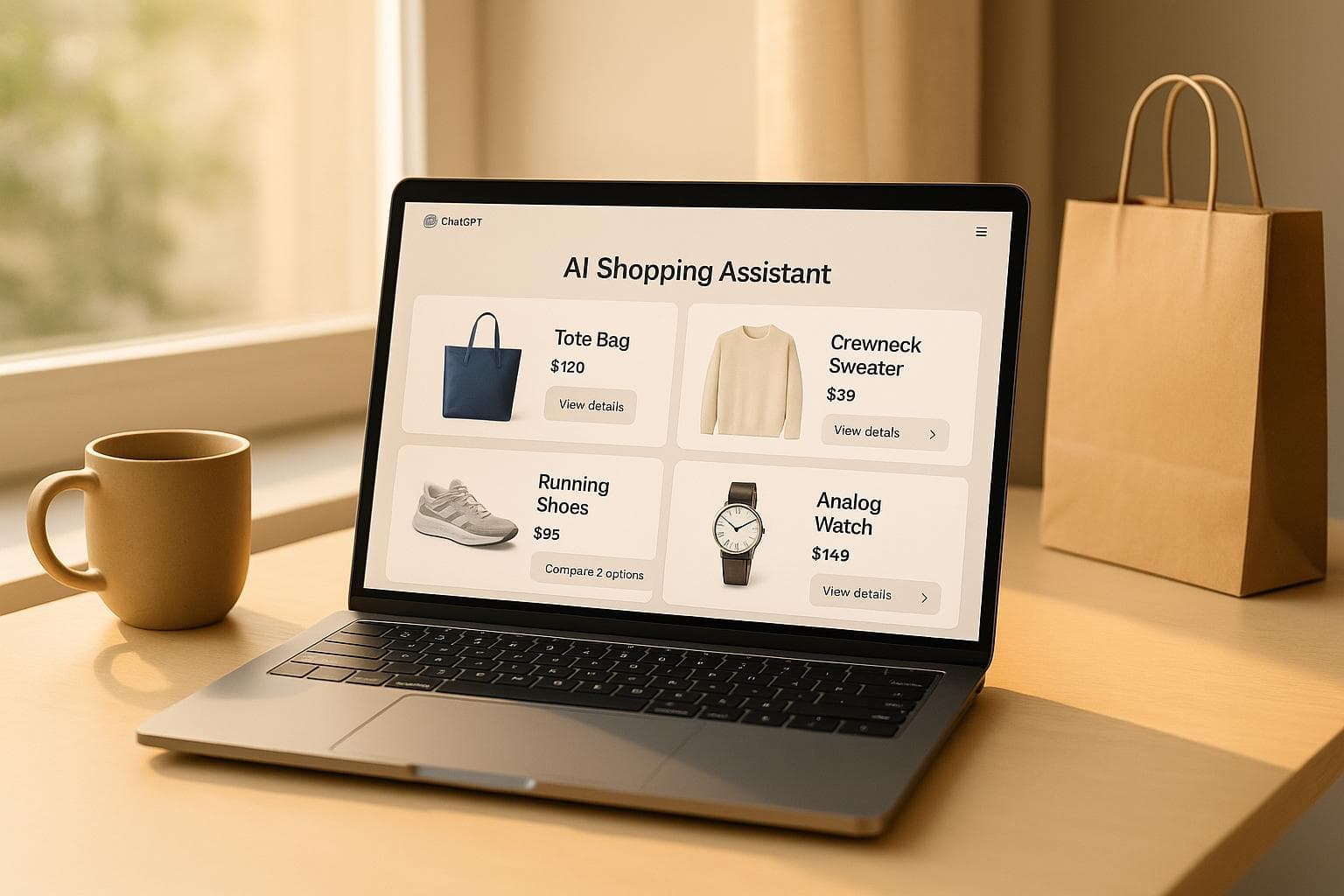AI-Powered Ad Optimization: What to Know
Explore how AI transforms e-commerce advertising through enhanced targeting, real-time optimization, and improved ROI for businesses.
AI-powered ad optimization is reshaping e-commerce advertising by automating tasks, improving targeting, and boosting ROI. Here's what you need to know:
What it does: AI analyzes user behavior, predicts customer intent, and adjusts ads in real time to maximize performance.
Why it matters: Businesses using AI in marketing see up to 40% revenue growth and 10-12% higher ROI.
Key trends: Hyper-personalization, cookieless targeting, and generative AI for creating ad copy and visuals.
How it works: Core technologies like machine learning, NLP, and predictive analytics enable smarter targeting, budget allocation, and real-time adjustments.
Real-world impact: Companies like Toyota and Adidas have seen significant increases in leads and conversion rates using AI-driven strategies.
AI isn't just a tool - it's a necessity for staying competitive in the $5.92 trillion e-commerce market. Early adoption offers a clear edge, with businesses reporting higher engagement, reduced costs, and streamlined campaign management. Ready to dive deeper? Let’s explore how AI is transforming advertising.
How Generative AI is Transforming Advertising
How AI-Powered Ad Optimization Works
AI is reshaping advertising by turning complex data into actionable strategies. From microsecond bid adjustments to managing multi-platform budgets, AI ensures campaigns are both efficient and profitable.
Core Technologies Behind AI Optimization
AI's effectiveness in advertising comes down to three key technologies: machine learning, natural language processing (NLP), and predictive analytics. Together, they process massive datasets, analyze customer behavior, and make decisions faster than any human could.
Machine Learning: Algorithms quickly identify patterns in customer behavior, creating accurate consumer profiles. Within milliseconds, they determine which users are most likely to take action based on both current and historical data [1][4].
Natural Language Processing (NLP): This enables AI to craft ad copy that resonates with specific audiences. By analyzing how different messaging styles, keywords, and calls-to-action perform, it generates personalized content tailored to various customer segments.
Predictive Analytics: Taking it a step further, predictive analytics forecasts future customer behavior. It predicts when a consumer is likely to make a purchase and identifies the messaging that will drive them to act.
These technologies work together to help advertisers achieve better results. For example, AI-powered audience targeting has been shown to boost ad performance by 30% while cutting costs by 25% [1]. Companies using AI in their ad campaigns report an average 76% increase in ROI compared to traditional methods [2].
The AI Optimization Process
AI ad optimization operates through a continuous, four-step process: data collection, audience segmentation, campaign creation, and real-time adjustments.
Data Collection and Audience Segmentation: AI gathers real-time data, analyzing customer intent, past interactions, and demographics. It then segments audiences dynamically, adapting as customer behaviors shift [4][5].
Campaign Creation and Deployment: AI generates personalized ads, chooses the best placements, and sets initial bid strategies. It simultaneously creates multiple ad versions tailored to different audience segments and platforms.
Real-Time Optimization: This is where AI truly excels. It continuously tweaks bids, budgets, targeting, and creative elements based on live performance data [3].
Real-world examples highlight the impact of AI. In 2021, Toyota used AI to analyze consumer data - such as purchase history and browsing behavior - to predict when customers were entering the car-buying cycle. This led to a 53% increase in qualified leads and a 21% rise in dealership visits [2]. Similarly, Stitch Fix analyzed over 30 customer data points, achieving a 45% boost in first-time customer acquisitions and a 21% drop in acquisition costs over a year [2].
Smart Budget Allocation and Cross-Channel Management
Managing budgets across multiple platforms is one of AI's standout capabilities. With 8 in 10 online purchases involving multiple touchpoints [7], traditional marketers often struggle to determine where to allocate resources. AI simplifies this by analyzing data from ad performance, customer behavior, market trends, and competitor activity [6].
AI identifies the top-performing channels and ad types for specific audiences, automatically shifting budgets to maximize ROI. It also reduces spending on underperforming campaigns, ensuring every dollar is spent wisely.
Programmatic Advertising is a prime example of AI's budget management prowess. By analyzing user behavior and demographics, AI makes real-time bidding decisions to place ads in front of the right audience at the perfect moment [6]. It continuously monitors performance, reallocating budgets to high-performing placements.
One standout tool is Google’s Performance Max, which spreads ads across Google’s entire network and adjusts targeting based on audience response [6]. This approach has delivered impressive results. For example, L'Oréal Vietnam achieved a 4.1X higher return on ad spend (ROAS) and a 13X higher conversion rate compared to previous campaigns [1].
E-commerce advertisers using AI for bidding and budget allocation report a 28% higher ROAS compared to manual campaign management [2].
The advantage lies in speed and scale. AI makes thousands of optimization decisions every hour, spotting trends and predicting performance. This allows advertisers to adjust budgets proactively, ensuring campaigns stay ahead of market shifts. By optimizing across all channels in real time, AI creates a cohesive advertising strategy that consistently delivers better results.
Key Benefits of AI-Powered Ad Optimization for E-commerce
AI-powered ad optimization is transforming how businesses manage their advertising efforts. By refining ad spend and boosting engagement, this technology delivers results that directly influence revenue - making it especially helpful for small and medium-sized businesses trying to stand out in competitive markets.
Better Targeting and Personalization
AI takes customer targeting to a whole new level by analyzing behavioral patterns and preferences on a massive scale. Instead of relying on broad demographic data, it creates tailored experiences that feel personal to each shopper.
Here’s the impact: AI can uncover up to 15 times more actionable customer segments compared to traditional methods. Campaigns using AI-driven audience insights show, on average, a 38% higher engagement rate than those relying on standard segmentation techniques[8]. The numbers don’t stop there - AI-powered ads lead to transaction rates six times higher than generic campaigns, a 131% increase in click-through rates, and a 41% overall boost in engagement[8].
Real-world examples make these benefits clear. Adidas, for instance, used AI to personalize its ad targeting, leading to a 30% jump in conversion rates across digital campaigns. By analyzing customer data - like past purchases, browsing habits, and seasonal trends - their system delivered recommendations that resonated with individual shoppers[8]. Similarly, Amazon’s recommendation engine, which tailors product suggestions, drives an estimated 35% of the company’s total sales[8].
"AI in advertising isn't just about doing things better - it's about doing things that weren't possible before." - Marketing executive at a Fortune 500 company[8]
AI also powers dynamic creative optimization, which adjusts ad content in real time based on user behavior. This ensures campaigns are always improving without the need for manual tweaks. The result? More effective targeting, higher engagement, and better cost efficiency.
Higher ROI and Lower CPA
The precision of AI targeting naturally leads to better financial outcomes. By focusing on users most likely to convert, AI eliminates waste and reallocates resources to strategies that perform well. It continuously analyzes performance data, making real-time adjustments to maximize returns.
Businesses that adopt AI in their marketing strategies report a 20–30% increase in ROI compared to those sticking with traditional methods[9]. Take The North Face, for example. Using IBM Watson’s AI, the company created personalized customer segments, achieving an incredible 75% conversion rate among interacting customers[10]. Additionally, AI-driven demand forecasting improves accuracy by 20–50%, helping companies manage inventory more efficiently and reduce losses[11].
To measure success, it’s crucial to track the right metrics. Setting SMART goals and establishing performance baselines before launching AI campaigns can help businesses evaluate improvements effectively[9].
Real-Time Analytics and Automation
AI doesn’t just improve targeting and reduce costs - it also provides immediate insights and automates time-consuming tasks. This is particularly valuable for small and medium-sized businesses that need to maximize efficiency.
By analyzing data in real time, AI can spot trends and patterns that might go unnoticed by humans. According to McKinsey, AI personalization can make marketing 10–30% more efficient, increase customer acquisition by 3–5%, and boost customer satisfaction and engagement by 5–10%[12].
AI also automates budget allocation, continuously monitoring performance metrics and shifting resources to high-performing ads - even outside regular business hours. This ensures campaigns stay optimized around the clock.
The practical benefits are clear. Wolseley, a UK-based heating and plumbing merchant, used advanced search and personalization tools to achieve a 9.6% increase in conversion rates and a 25% rise in average order value. Their revenue per visitor grew by about $31.00[12]. Similarly, Bensons for Beds revamped their digital strategy with AI-powered customer journey personalization. By focusing on tailored email marketing and leveraging customer data, they saw a 41% year-over-year increase in e-commerce sales and a 7% boost in Q4 2022 like-for-like sales[12].
For small businesses, starting with AI doesn’t have to be overwhelming. Analyzing customer data can help improve marketing precision and effectiveness. AI tools can automate tasks like audience segmentation, optimizing email send times, and identifying at-risk customers for targeted retention campaigns. Predictive analytics also allows businesses to anticipate customer behavior, enabling them to adjust their strategies proactively.
sbb-itb-0bd1697
Feedcast: AI-Powered Ad Optimization Made Simple

Feedcast delivers a streamlined solution for businesses looking to optimize their advertising efforts with AI. Trusted by over 2,500 brands, the platform has facilitated the distribution of more than 2 million products, generated upwards of 73 million clicks, and driven sales exceeding $133 million [14].
Centralized Multi-Channel Advertising Management
Managing ad campaigns across platforms like Google, Facebook, Instagram, and Microsoft Ads can be overwhelming. Feedcast simplifies this by bringing all your ad accounts together in one unified dashboard.
This dashboard provides real-time metrics and customized reports, making it easy to allocate budgets dynamically. By analyzing performance across channels, you can quickly identify which platforms are delivering the best results and adjust your resources accordingly. Feedcast’s data-driven insights ensure your advertising spend is optimized for maximum impact [15].
Additionally, the platform integrates product and ad creation tools into this centralized system, creating a smooth and cohesive optimization process.
AI-Powered Product Feed Management
For e-commerce businesses, managing product feeds often feels like navigating a maze. Poorly managed product data can lead to ad rejections, low visibility, and lost sales opportunities. Feedcast tackles this head-on with its AI-powered product feed management tools.
The platform connects seamlessly with popular e-commerce systems like Shopify, WooCommerce, and Prestashop, and supports imports from formats like Google Sheets, CSV, XML, and TXT [13]. This integration simplifies the process of syncing product data.
What truly sets Feedcast apart is its AI-driven data enrichment. It automatically enhances product titles and descriptions, fills in missing details, and optimizes product information to improve visibility across ad channels. On top of that, error detection tools catch issues before they can disrupt your campaigns. Features like mass product editing and custom label management help you organize products effectively and allocate budgets more strategically.
These tools are designed to improve ad performance and drive better campaign results.
"After testing shopping campaigns without much success on my own, I tried Feedcast. Campaigns were quickly set up and the results quickly evolved in a very positive way. Additionally, the support is very responsive to any questions asked!" - Léa Moller, CEO at Nid de Famille [14]
Automated Ad Creation and Optimization
Feedcast takes the guesswork out of ad creation. Its AI crafts tailored ad copy for each platform, while smart targeting refines audience selection and reallocates budgets to balance customer acquisition and retention. By leveraging advanced targeting capabilities from Google and Meta, Feedcast helps you connect with new customers and re-engage existing ones [13].
The platform’s optimization tools identify your most valuable customers and engaged audiences, ensuring your budget is focused on prospects with the highest potential. Smart shopping campaigns, powered by enhanced product data and precise targeting, boost visibility and conversions across Google’s shopping network.
"We needed an effective SEA solution, and Feedcast was able to meet our request quickly and at a low cost. This is the first month we have worked with Feedcast, and the return on investment is as expected!" - Antoine LEGUEZ, Digital Project Manager [14]
Feedcast offers flexible pricing plans to suit various business needs. There’s a free plan for up to 1,000 products, the Autopilot plan at $99/month for 1,000 products across multiple channels with 500 AI credits, and the Premium plan at $249/month (discounted to $149 for the first month) for unlimited access [14].
Conclusion: Using AI for Smarter E-commerce Advertising
AI-powered ad optimization has become a game-changer for e-commerce businesses aiming to stay ahead in a competitive market. With more than half of e-commerce companies already leveraging AI technologies [18], those who delay risk being left behind in an increasingly automated world. The efficiency gains AI provides are reshaping how businesses approach advertising, unlocking opportunities across every corner of the industry.
Take personalized recommendations, for example. AI-driven systems have been shown to increase conversion rates by 15–20% while cutting customer acquisition costs by as much as 50% [18]. For small and medium-sized businesses, these kinds of improvements can make the leap from tedious manual campaign management to sustainable growth a reality.
The adoption of AI is picking up speed. In 2024, 40% of small businesses reported using generative AI - almost double the figure from the previous year [17]. This rapid shift highlights the growing demand for tools that can adapt on the fly, something AI handles with ease.
AI thrives on processing enormous amounts of data in real time, enabling campaigns to adjust instantaneously to changes in the market, competitor moves, or customer behavior [16]. This kind of dynamic optimization is simply out of reach for traditional manual bidding strategies.
"The future of paid advertising lies not in reaching more people, but in reaching exactly the right people with exactly the right message at exactly the right time. AI makes this level of precision possible." – Eric Siu, CEO of Single Grain [16]
Feedcast is a prime example of how AI is revolutionizing ad management. By centralizing campaign controls, automating product feed optimization, and generating smarter ad content, Feedcast simplifies the complex process of managing multi-channel campaigns.
To get started, businesses need to define clear goals and select tools that enhance targeting, automate repetitive tasks, and enable scalability. When implemented effectively, AI-driven solutions can boost profitability by up to 25% [19].
As e-commerce continues to evolve, companies harnessing AI-powered ad optimization are better positioned to seize new opportunities, improve customer experiences, and achieve lasting growth in an increasingly competitive digital landscape.
FAQs
How does AI-powered ad optimization enhance targeting and personalization in e-commerce advertising?
AI-driven ad optimization is changing the game when it comes to targeting and personalization. By leveraging real-time data analysis and machine learning, it crafts highly detailed audience profiles. Unlike older strategies that depended on general demographics, AI dives deeper, analyzing individual behaviors, preferences, and interactions to deliver messages that truly connect with potential customers.
This smarter approach helps businesses connect with the right audience at the perfect moment, boosting both engagement and conversion rates. On top of that, AI handles ad placements automatically and fine-tunes campaigns continuously, ensuring they perform better while squeezing the most out of every dollar spent.
How can small and medium-sized businesses save money by using AI for advertising?
Small and medium-sized businesses (SMBs) can cut costs on advertising by leveraging AI tools to handle tasks like creating ads, targeting audiences, and optimizing campaigns. These tasks, which often demand a lot of time and money, become much simpler with AI, reducing the need to hire expensive agencies or freelancers. This means SMBs can launch effective campaigns more quickly and affordably.
AI also boosts return on investment (ROI) by delivering ads that are better tailored to the right audience, leading to higher engagement and more sales. With AI handling performance tracking and audience segmentation, SMBs can stretch their ad budgets further, focusing on strategies that deliver results - even with limited resources.
How can businesses use AI to improve their advertising campaigns?
Businesses today are turning to AI tools like machine learning and predictive analytics to sharpen their advertising strategies. Predictive analytics helps businesses anticipate customer behavior, enabling them to craft personalized and relevant ads that capture attention and boost conversions.
Machine learning steps in to analyze massive datasets in real-time, fine-tuning ad placements, bidding strategies, and audience targeting. This means every dollar spent on advertising works harder, reaching the people most likely to engage. By weaving these technologies into their advertising efforts, companies can simplify operations, strengthen customer relationships, and stay ahead in a constantly evolving market.
Yohann B.










